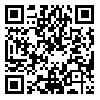Volume 38 - Continuously Updated
IJN 2025, 38 - Continuously Updated: 0-0 |
Back to browse issues page
Download citation:
BibTeX | RIS | EndNote | Medlars | ProCite | Reference Manager | RefWorks
Send citation to:



BibTeX | RIS | EndNote | Medlars | ProCite | Reference Manager | RefWorks
Send citation to:
Sharei Z, Zakeri Bahmani M. The Relationship Between Work-Family Dynamics and Their Impact on the Mental Health of Nurses Employed in Public Hospitals in Tehran During the Post-Pandemic Period. IJN 2025; 38 (S1 )
URL: http://ijn.iums.ac.ir/article-1-3892-en.html
URL: http://ijn.iums.ac.ir/article-1-3892-en.html
1- Department of Management, Faculty of Management, Economics and Accounting, Payame Noor University, Tehran, Iran. , z_sharei@pnu.ac.ir
2- Department of Management, Faculty of Management, Economics and Accounting, Payame Noor University, Tehran, Iran.
2- Department of Management, Faculty of Management, Economics and Accounting, Payame Noor University, Tehran, Iran.
Abstract: (991 Views)
Background & Aims Work-life culture can affect workplace well-being and work-family conflict of nurses. This study aimed to examine the effect of work-family culture and work-family conflict on the workplace well-being of Iranian nurses working in public hospitals.
Materials & Methods This is a descriptive-correlational study using structural equation modeling. The statistical population consisted of 200 married nurses from public hospitals providing care to COVID-19 patients in Tehran, Iran. We selected 127 eligible nurses using a stratified proportional sampling method. Data were collected using Thompson et al.’s work-family culture scale, Carlson et al.’s work-family conflict scale, and Page’s WWB Scale, and analyzed in SmartPLS software, version 3.
Results Work-family culture had a significant positive effect on WWB (β=0.806, t=10.112, P<0.001). Work-family conflict showed a significant negative impact on WWB (β=-0.448, t=-4.302, P<0.001), while work-family culture significantly reduced work-family conflict (β=-0.588, t=-6.752, P<0.01). Work-family conflict significantly mediated the relationship between work-family culture and WWB (β=0.20, P<0.05).
Conclusion Enhancing work-family culture and reducing work-family conflict can improve nurses’ WWB. The results can be helpful for the development of organizational interventions.
Materials & Methods This is a descriptive-correlational study using structural equation modeling. The statistical population consisted of 200 married nurses from public hospitals providing care to COVID-19 patients in Tehran, Iran. We selected 127 eligible nurses using a stratified proportional sampling method. Data were collected using Thompson et al.’s work-family culture scale, Carlson et al.’s work-family conflict scale, and Page’s WWB Scale, and analyzed in SmartPLS software, version 3.
Results Work-family culture had a significant positive effect on WWB (β=0.806, t=10.112, P<0.001). Work-family conflict showed a significant negative impact on WWB (β=-0.448, t=-4.302, P<0.001), while work-family culture significantly reduced work-family conflict (β=-0.588, t=-6.752, P<0.01). Work-family conflict significantly mediated the relationship between work-family culture and WWB (β=0.20, P<0.05).
Conclusion Enhancing work-family culture and reducing work-family conflict can improve nurses’ WWB. The results can be helpful for the development of organizational interventions.
Type of Study: Research |
Subject:
nursing
Received: 2025/03/22 | Accepted: 2025/03/21 | Published: 2025/03/21
Received: 2025/03/22 | Accepted: 2025/03/21 | Published: 2025/03/21
Send email to the article author
| Rights and permissions | |
 |
This work is licensed under a Creative Commons Attribution-NonCommercial 4.0 International License. |







